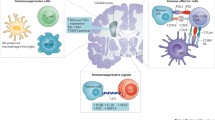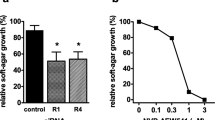Abstract
Autologous glioblastoma multiforme tumor cells treated with an antisense oligodeoxynucleotide (AS-ODN) targeting insulin-like growth factor receptor-1 (IGF-1R) are the basis of a vaccine with therapeutic effects on tumor recurrence in a pilot clinical trial. As a preface to continued clinical investigation of this vaccination strategy, we have studied the contribution of an optimized IGF-1R AS-ODN, designated “NOBEL”, to the induction of immunity to mouse GL261 glioma cells. The impact of NOBEL on mechanisms contributing to the development of GL261 immunity was first examined in the periphery. GL261 cells are naturally immunogenic when implanted into the flanks of congenic C57BL/6 mice, immunizing rather than forming tumors in around 50 % of these animals but causing tumors in the majority of mice lacking T and B lymphocytes. Overnight treatment with NOBEL in vitro reduces IGF-1R expression by GL261 cells but has minimal effect on cell viability and does not reduce the capacity of the cells to form tumors upon implantation. In contrast, tumors are extremely rare when GL261 cells are mixed with NOBEL at inoculation into the flanks of C57BL/6, and the recipient mice become immune to subcutaneous and intracranial challenge with untreated GL261. Adaptive immune mechanisms contribute to this effect, as immunocompromised mice fail to either fully control tumor formation or develop immunity following flank administration of the GL261/NOBEL mix. NOBEL’s structure has known immunostimulatory motifs that likely contribute to the immunogenicity of the mix, but its specificity for IGF-1R mRNA is also important as a similarly structured sense molecule is not effective.






Similar content being viewed by others
Abbreviations
- AS-ODN:
-
Antisense oligodeoxynucleotide
- APC:
-
Antigen presenting cells
- BBB:
-
Blood–brain barrier
- B2M−/− :
-
Beta-2 microglobulin knockout (CD8 T deficient)
- CELISA:
-
Cell-based ELISA
- DLN:
-
Draining lymph nodes
- ELISA:
-
Enzyme-linked immunosorbent assay
- FBS:
-
Fetal bovine sera
- GBM:
-
Glioblastoma multiforme
- IGF-1R:
-
Insulin-like growth factor 1 receptor
- JHD−/− :
-
Antibody heavy chain knockout (B cell deficient)
- MFI:
-
Mean fluorescence intensity
- NKT:
-
Natural killer T cells
- PBS:
-
Phosphate-buffered saline
- qRT-PCR:
-
Quantitative real-time polymerase chain reaction
- Rag2−/− :
-
Recombination activating gene 2 knockout (T and B deficient)
- TLR9:
-
Toll-like receptor 9
References
Smith JS, Jenkins RB (2000) Genetic alterations in adult diffuse glioma: occurrence, significance, and prognostic implications. Front Biosci 5:D213–D231
Louis DN (2006) Molecular pathology of malignant gliomas. Annu Rev Pathol 1:97–117
Avgeropoulos NG, Batchelor TT (1999) New treatment strategies for malignant gliomas. Oncologist 4:209–224
Jackson C, Ruzevick J, Phallen J, Belcaid Z, Lim M (2011) Challenges in immunotherapy presented by the glioblastoma multiforme microenvironment. Clin Dev Immunol 2011:732413
Madan RA, Gulley JL (2011) Therapeutic cancer vaccine fulfills the promise of immunotherapy in prostate cancer. Immunotherapy 3:27–31
Disis ML (2011) Immunologic biomarkers as correlates of clinical response to cancer immunotherapy. Cancer Immunol Immunother 60:433–442
Pachter JS, de Vries HE, Fabry Z (2003) The blood-brain barrier and its role in immune privilege in the central nervous system. J Neuropathol Exp Neurol 62:593–604
Candolfi M, Curtin JF, Yagiz K et al (2011) B cells are critical to T-cell-mediated antitumor immunity induced by a combined immune-stimulatory/conditionally cytotoxic therapy for glioblastoma. Neoplasia 13:947–960
Tran Thang NN, Derouazi M, Philippin G et al (2010) Immune infiltration of spontaneous mouse astrocytomas is dominated by immunosuppressive cells from early stages of tumor development. Cancer Res 70:4829–4839
Vauleon E, Avril T, Collet B, Mosser J, Quillien V (2010) Overview of cellular immunotherapy for patients with glioblastoma. Clin Dev Immunol. Article ID 689171. doi:10.1155/2010/689171
Andrews DW, Resnicoff M, Flanders AE et al (2001) Results of a pilot study involving the use of an antisense oligodeoxynucleotide directed against the insulin-like growth factor type I receptor in malignant astrocytomas. J Clin Oncol 19:2189–2200
Hernandez-Sanchez C, Blakesley V, Kalebic T, Helman L, LeRoith D (1995) The role of the tyrosine kinase domain of the insulin-like growth factor-I receptor in intracellular signaling, cellular proliferation, and tumorigenesis. J Biol Chem 270:29176–29181
Liu S, Jin F, Dai W, Yu Y (2010) Antisense treatment of IGF-IR enhances chemosensitivity in squamous cell carcinomas of the head and neck. Eur J Cancer 46:1744–1751
Shen YM, Yang XC, Yang C, Shen JK (2008) Enhanced therapeutic effects for human pancreatic cancer by application K-ras and IGF-IR antisense oligodeoxynucleotides. World J Gastroenterol 14:5176–5185
Resnicoff M, Huang Z, Herbert D, Abraham D, Baserga R (1997) A novel class of peptides that induce apoptosis and abrogate tumorigenesis in vivo. Biochem Biophys Res Commun 240:208–212
Durfort T, Tkach M, Meschaninova MI et al (2012) Small interfering RNA targeted to IGF-IR delays tumor growth and induces proinflammatory cytokines in a mouse breast cancer model. PLoS ONE 7:e29213
Schillaci R, Salatino M, Cassataro J et al (2006) Immunization with murine breast cancer cells treated with antisense oligodeoxynucleotides to type I insulin-like growth factor receptor induced an antitumoral effect mediated by a CD8+ response involving Fas/Fas ligand cytotoxic pathway. J Immunol 176:3426–3437
Stein CA (1995) Does antisense exist? Nat Med 1:1119–1121
Stein CA, Subasinghe C, Shinozuka K, Cohen JS (1988) Physicochemical properties of phosphorothioate oligodeoxynucleotides. Nucleic Acids Res 16:3209–3221
Krieg AM, Yi AK, Matson S et al (1995) CpG motifs in bacterial DNA trigger direct B-cell activation. Nature 374:546–549
Kobayashi N, Hong C, Klinman DM, Shirota H (2013) Oligodeoxynucleotides expressing polyguanosine motifs promote antitumor activity through the upregulation of IL-2. J Immunol 190:1882–1889
Peng G, Guo Z, Kiniwa Y et al (2005) Toll-like receptor 8-mediated reversal of CD4+ regulatory T cell function. Science 309:1380–1384
Pasare C, Medzhitov R (2003) Toll pathway-dependent blockade of CD4+ CD25+ T cell-mediated suppression by dendritic cells. Science 299:1033–1036
Iho S, Yamamoto T, Takahashi T, Yamamoto S (1999) Oligodeoxynucleotides containing palindrome sequences with internal 5′-CpG-3′ act directly on human NK and activated T cells to induce IFN-gamma production in vitro. J Immunol 163:3642–3652
Baserga R, Resnicoff M, D’Ambrosio C, Valentinis B (1997) The role of the IGF-I receptor in apoptosis. Vitam Horm 53:65–98
Szatmari T, Lumniczky K, Desaknai S et al (2006) Detailed characterization of the mouse glioma 261 tumor model for experimental glioblastoma therapy. Cancer Sci 97:546–553
Ausman JI, Shapiro WR, Rall DP (1970) Studies on the chemotherapy of experimental brain tumors: development of an experimental model. Cancer Res 30:2394–2400
Phares TW, Kean RB, Mikheeva T, Hooper DC (2006) Regional differences in blood-brain barrier permeability changes and inflammation in the apathogenic clearance of virus from the central nervous system. J Immunol 176:7666–7675
Resnicoff M, Abraham D, Yutanawiboonchai W et al (1995) The insulin-like growth factor I receptor protects tumor cells from apoptosis in vivo. Cancer Res 55:2463–2469
Resnicoff M, Li W, Basak S, Herlyn D, Baserga R, Rubin R (1996) Inhibition of rat C6 glioblastoma tumor growth by expression of insulin-like growth factor I receptor antisense mRNA. Cancer Immunol Immunother 42:64–68
Liu X, Turbyville T, Fritz A, Whitesell L (1998) Inhibition of insulin-like growth factor I receptor expression in neuroblastoma cells induces the regression of established tumors in mice. Cancer Res 58:5432–5438
Bernasconi NL, Traggiai E, Lanzavecchia A (2002) Maintenance of serological memory by polyclonal activation of human memory B cells. Science 298:2199–2202
Jung J, Yi AK, Zhang X, Choe J, Li L, Choi YS (2002) Distinct response of human B cell subpopulations in recognition of an innate immune signal, CpG DNA. J Immunol 169:2368–2373
Krieg AM (2002) CpG motifs in bacterial DNA and their immune effects. Annu Rev Immunol 20:709–760
Samulowitz U, Weber M, Weeratna R et al (2010) A novel class of immune-stimulatory CpG oligodeoxynucleotides unifies high potency in type I interferon induction with preferred structural properties. Oligonucleotides 20:93–101
Alizadeh D, Zhang L, Brown CE, Farrukh O, Jensen MC, Badie B (2010) Induction of anti-glioma natural killer cell response following multiple low-dose intracerebral CpG therapy. Clin Cancer Res 16:3399–3408
Grauer OM, Molling JW, Bennink E et al (2008) TLR ligands in the local treatment of established intracerebral murine gliomas. J Immunol 181:6720–6729
Biollaz G, Bernasconi L, Cretton C et al (2009) Site-specific anti-tumor immunity: differences in DC function, TGF-beta production and numbers of intratumoral Foxp3+ Treg. Eur J Immunol 39:1323–1333
Brown CE, Starr R, Martinez C et al (2009) Recognition and killing of brain tumor stem-like initiating cells by CD8+ cytolytic T cells. Cancer Res 69:8886–8893
Smith KE, Fritzell S, Badn W et al (2009) Cure of established GL261 mouse gliomas after combined immunotherapy with GM-CSF and IFNgamma is mediated by both CD8+ and CD4+ T-cells. Int J Cancer 124:630–637
Perricone MA, Smith KA, Claussen KA et al (2004) Enhanced efficacy of melanoma vaccines in the absence of B lymphocytes. J Immunother 27:273–281
Shah S, Divekar AA, Hilchey SP et al (2005) Increased rejection of primary tumors in mice lacking B cells: inhibition of anti-tumor CTL and TH1 cytokine responses by B cells. Int J Cancer 117:574–586
Ghulam Muhammad AK, Candolfi M, King GD et al (2009) Antiglioma immunological memory in response to conditional cytotoxic/immune-stimulatory gene therapy: humoral and cellular immunity lead to tumor regression. Clin Cancer Res 15:6113–6127
Acknowledgments
The authors gratefully acknowledge technical support provided by Rhonda B. Kean and Emily Bongiorno. This work was funded by the generous support of the Albert F. Stevens Foundation through a grant to David W. Andrews.
Conflict of Interest
The authors declare that they have no conflict of interest.
Author information
Authors and Affiliations
Corresponding author
Additional information
Mélanie Morin-Brureau and Kirsten M. Hooper made equal contributions to this work.
Electronic supplementary material
Below is the link to the electronic supplementary material.
Rights and permissions
About this article
Cite this article
Morin-Brureau, M., Hooper, K.M., Prosniak, M. et al. Enhancement of glioma-specific immunity in mice by “NOBEL”, an insulin-like growth factor 1 receptor antisense oligodeoxynucleotide. Cancer Immunol Immunother 64, 447–457 (2015). https://doi.org/10.1007/s00262-015-1654-z
Received:
Accepted:
Published:
Issue Date:
DOI: https://doi.org/10.1007/s00262-015-1654-z




